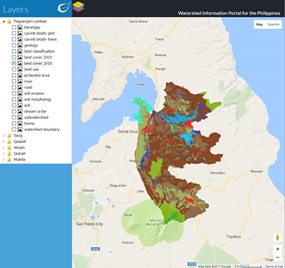To address the degradation and ensure the sustainability of the country’s watersheds, six watersheds located all over the country were assigned as Learning Watersheds.
Titled, National Research and Development Project for Watershed Management in the Philippines (NRDPWMP), the project is funded by the Philippine Council for Agriculture, Aquatic and Natural Resources Research and Development of the Department of Science and Technology (DOST-PCAARRD).
Also called INWARD or the Integrated National Watershed Research and Development Project, the undertaking aims to gather data and information geared towards guiding policy decisions. These include the kind and extent of allowable land uses and practices in a given watershed to avoid impairing the sustainability of surface and ground water resources.
Watersheds provide livelihoods as well as domestic, agricultural, and ecological water maintenance services.
 The Learning Watersheds include Pagsanjan-Lumban Watershed in Laguna, Quiaoit River Watershed in Ilocos Norte, Saug Watershed in Davao del Norte, Abuan Watershed in Isabela, Muleta Watershed in Bukidnon, and Quinali Watershed in Albay. They were identified to represent the many unique bioclimatic and physiographic typologies across the country and ensure that the database covers as much diverse biophysical and socioeconomic watershed conditions.
The Learning Watersheds include Pagsanjan-Lumban Watershed in Laguna, Quiaoit River Watershed in Ilocos Norte, Saug Watershed in Davao del Norte, Abuan Watershed in Isabela, Muleta Watershed in Bukidnon, and Quinali Watershed in Albay. They were identified to represent the many unique bioclimatic and physiographic typologies across the country and ensure that the database covers as much diverse biophysical and socioeconomic watershed conditions.
To gather data and information from the watersheds, several integrated monitoring systems, which include sensor aided devices, monitoring plots, and socioeconomic survey tools were installed. Baseline watershed profiles on climate, hydrology, soil, biodiversity, and socioeconomic circumstances, among others, were also completed. These data are stored in the project’s website, www.philwatershed.org, which also serves as a web-based database management system.
The project also developed a set of standard protocols for monitoring various climatological, hydrological, biological, edaphic, and socioeconomic features, and for processing the datasets that are being generated.
Continuous monitoring of the watersheds under the project is expected to help improve the precision of management and policy decisions in promoting secured water supply, sustainable livelihoods, reduced risks due to climate change, and reversal of pervasive watershed degradation in the country, among others.
Moreover, the data and information from the project will be useful in determining the optimum combination of major uses of watersheds such as power generation, biodiversity conservation, flood control, and irrigation.
